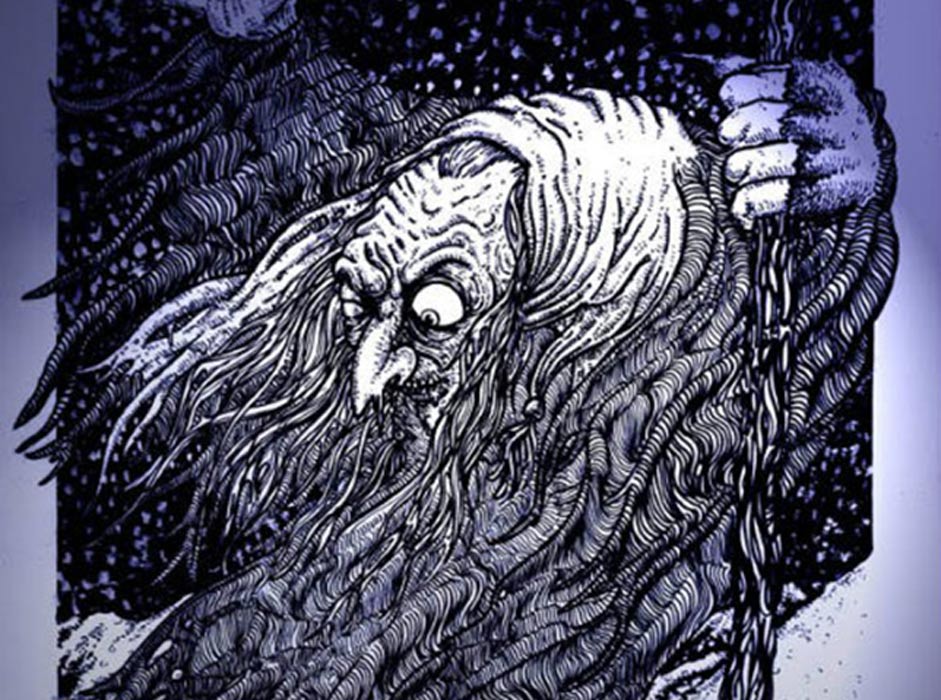Beira, Queen of Winter
In Scottish folklore, Beira is said to be the goddess of winter. According to some sources, she is known also as the Cailleach, a name which is said to be translated literally into English from Gaelic as ‘veiled one’. Apart from Scottish folklore, this figure can also be found in the mythology of Ireland, though she is called by a slightly different name. Moreover, it has been pointed out that such a wintry figure can also be found in the beliefs of the various ancient groups that inhabited the British Isles.
According to the folklorist Donald Alexander Mackenzie, who published the Wonder Tales from Scottish Myth and Legend in 1917, Beira was not merely a goddess of winter, but also the “mother of all the gods and goddesses in Scotland.” Although she is said to have been a creator goddess, Beira was also the type of deity who ruled through fear. Although her reign was undisputed during the winter, when spring came, her subjects would begin to rebel against her rule. Furthermore, her subjects looked forward to the coming of Angus and Bride, the King and Queen of Summer and Plenty.
- The Snow Maiden of Slavic Folklore: Magical Characters of Winter from Russia
- Meet Father Frost and his Fairy Goddaughter Snow Maiden: Magical Characters of Winter from Russia
In some versions of the tale, Beira is said to be an old blue hag with one eye. According to one source, Beira’s possession of one eye symbolizes her ability to see beyond duality, and into the oneness of all beings. In one version of the tale in which Beira is portrayed as a hag, the Queen of Winter seeks the love of a hero. If the hero accepts her, she would transform into a beautiful young maiden. This transformation is meant to symbolize the seeds that lay dormant in the earth during the winter, which would begin sprout with the arrival of spring. Thus, Beira is seen not as an opponent of spring, but as spring itself.

Cailleach, The Goddess of Winter. (Image Source)
In yet another version of the tale, Beira is said to carry a magic staff which froze the ground with each tap. At the end of each winter, she would throw her staff under the holly and the gorse bush. These are believed to be her sacred trees. Then, the goddess transforms into a grey stone, which is a signal that winter has ended.
In some tales, Beira is said to be the guardian of the life force. In this role, she would find and nourish the seeds buried in the earth, thus bringing them to life during the spring. Thus, Beira is also regarded as a goddess of death and rebirth. Another connection between Beira and the natural world is that she is the guardian of animals during the winter, protecting them during this harsh season.
- The Icelandic Kvöldvaka: Cultural Phenomenon in the Twilight Hours
- Veles and Perun: The Legendary Battle of Two Slavic Gods
There are also stories that link Beira to specific locations. One such story is that of the creation of Loch Awe. In this tale, Beira is said to have been in charge of a well on the top of Ben Cruachan in Argyll. Beira was responsible for stopping the water from flowing each evening by covering the mouth of the well with a stone cover. When the sun rose the next morning, she would remove the cover, thus allowing the water to flow again.

Ben Cruachan ridge. (CC BY-SA 2.0)
One evening, Beira fell asleep by the side of the well out of exhaustion, and forgot to cover it. As a result, the water flowed throughout the night, breaking through at the Pass of Brander, and creating Loch Awe. In addition, many people and animals were drowned by the waters. When Beira woke up, she was so horrified by what she had done that she turned to stone.
Top image: An image of Beira. Photo source: Image Source
By Wu Mingren
References
Craignish Cruises, 2016. The Cailleach, or Hag of Winter. [Online]
Available at: http://www.whirlpool-scotland.co.uk/cailleach.html
Education Scotland, 2016. Bride and Angus. [Online]
Available at: http://www.educationscotland.gov.uk/scotlandsstories/brideandangus/index.asp
Mackenzie, D. A., 1917. Wonder Tales from Scottish Myth and Legend. [Online]
Available at: http://www.sacred-texts.com/neu/celt/tsm/index.htm
Mysterious Britain & Ireland, 2016. The Caillech Bheur. [Online]
Available at: http://www.mysteriousbritain.co.uk/scotland/folklore/the-caillech-bheur.html
Shaw, J., 2012. Cailleach, The Queen of Winter. [Online]
Available at: https://feminismandreligion.com/2012/12/19/cailleach-the-queen-of-winter-by-judith-shaw/
swampy, 2016. Cailleach, Celtic Crone Goddess. [Online]
Available at: http://dutchie.org/goddess-cailleach/




















Comments
Beira is the slightly modified name of BaRa Godess Creator of Ancient Bulgarians. Ba/BaTa/BaRa / BraMa means the Grand Ma, the old lady, the first who created the universe. BaRa is the Absolute Godess of first human beings on earth the enlightened mystics and Godly people Ancient Bulgarians, who appeared in the caves of North West Bulgaria. Those caves are still called by local people Cave Wombs.
- https://www.facebook.com/photo.php?fbid=920127591440198&set=a.313566...